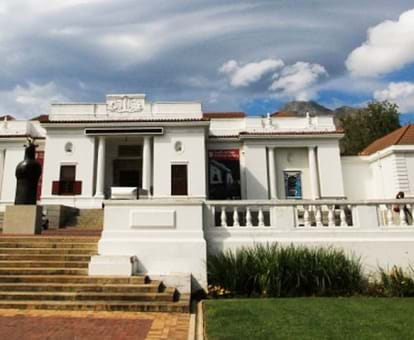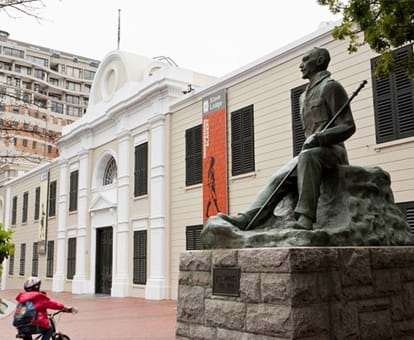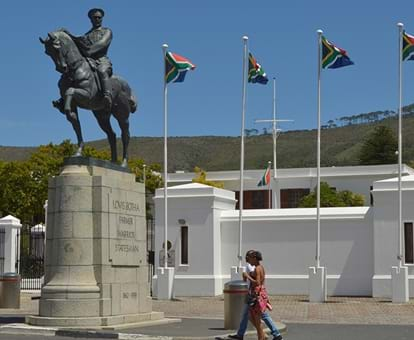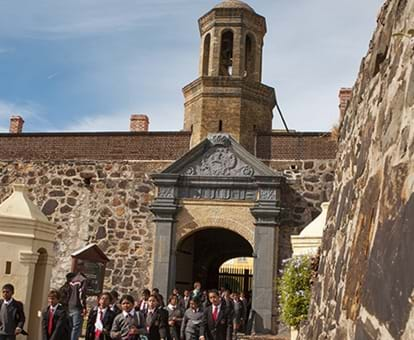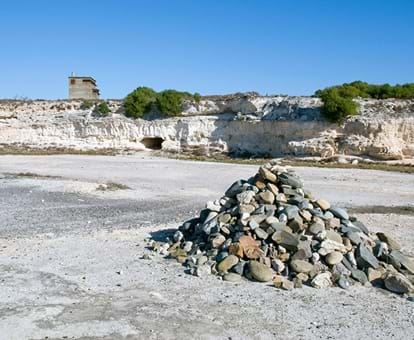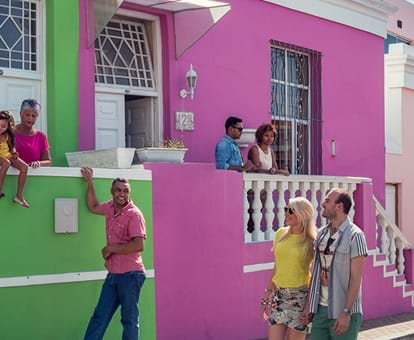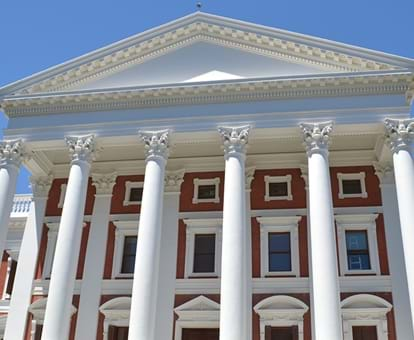By creating an account, I agree to the
Terms of service and Privacy policy
Choose your country and language:
Africa
Americas
Asia Pacific
Europe
CCape Town is South Africa’s oldest city, but its encircling mountains, Devil’s Peak, Table Mountain and Lion’s Head, have witnessed a longer history than that described by its surviving historic buildings. To catch an echo of Cape Town’s ancient past, you should start at the Company Gardens, where the Fresh River that provided water to the Khoekhoe and their herds, and attracted San hunters before them, still runs in canals flanking the leafy avenue.
The sheltering mountains, and the fresh water flowing from them, later attracted European settlers, and the Company Gardens and the Castle of Good Hope stand testimony to this early incursion into and settlement of the area. The Gardens were established by the Dutch East India Company (VOC) from 1652 as a refreshment station, providing fresh fruit and vegetables for passing ships en route to the East, while the Castle was built in 1666 to defend the few who tended the garden, supplied the ships, and kept law and order among the settlers. The Gardens themselves are a wonderful, shady respite from the busy city, with characterful trees and bursts of vibrant blooms, while the Houses of Parliament, National Gallery, Iziko Museum and Planetarium, National Library of South Africa and Centre for the Book are all located around its edges. The Castle, squat and solid from the outside, contains layers of history within its walls, from the bleak horrors of its cramped prison cells and the Dark Hole, complete with graffiti from prisoners, to the grand elegance of the ochre-coloured apartments and the Dolphin Pool. Not to be missed are the daily rituals of the key ceremony and the firing of the cannon.
TThe VOC never intended the financial and administrative burden of establishing a settlement here, and the expansion and populating of the town occurred despite the VOC’s presence here, not because of it. The settlement quickly outgrew the confines and security of the Castle, however, and one of the earliest buildings constructed outside the Castle walls is the Slave Lodge, built in 1679, located at the entrance to the Company Gardens. This structure now houses a museum that uses dynamic exhibitions to tell the story of slavery at the Cape, tracing the thread of historic oppression and resistance through to South Africa’s recent past.
The burgeoning town, thanks to its location on a much-travelled trade route, quickly became cosmopolitan, with passersby and settlers coming from across Europe as well as locations throughout the East. This cultural mix is evident in the old religious buildings in the city, and each of these tells the history of a different sector of the Cape’s early history. The earliest church was the Dutch Reformed Groote Kerk, originally built in 1678. All that remains of this early structure is the tower, which was incorporated in the current building when it was rebuilt in 1841. The antiquity of Cape Town’s mosques, the Auwal Mosque, built in 1794 on Dorp Street, and the Palm Tree Mosque, built in the early 1800s on Long Street, attests to the early establishment of Islam in Cape Town, which flourished among slaves and ex-slaves, often under the tutelage of prominent scholars and imams who had been exiled to the Cape by the VOC.
German Lutherans conducted their worship in a complex of buildings on the corner of Buitengracht and Strand streets from the 1780s onwards, and this complex today forms one of the best preserved historic precincts in the city. It also houses the Gold of Africa Museum, which celebrates both the ancient and recent technological and artistic achievements of goldsmiths across Africa.
LLong Street is also home to the Slave Church, built for the South African Missionary Society between 1799 and 1802 to provide literacy and religious instruction to slaves. This building contains changing exhibitions related to themes of slavery and injustice. No visit to Cape Town would be complete without taking in the majesty of St George’s Cathedral. This building, built by famed architect Sir Herbert Baker in 1901 out of Table Mountain sandstone, is magnificent in its own right, with impressive gothic styling and extraordinary stained glass windows. However, it was through its vocal stand against the apartheid government and support for activists and opponents to that rule, most notably under Archbishop Emeritus Desmond Tutu, that the church earned its popular name, “the people’s cathedral”.
If you only have a few hours to spare in the city, to appreciate its multifaceted past, all you need to do is walk its streets. Long Street’s colonnades protect generously appointed Edwardian shop fronts from sun and rain, and looking up from street level you can take in the gracious Victorian facades with sunny balconies above. The majority of these old buildings have been lovingly restored, many in vibrant colours, and now house exciting restaurants and bars and eclectic shops. Bree Street (wide street) was designed to allow turning space for produce-laden wagons delivering their fare to Greenmarket Square. Historic buildings along this road include Cape Town’s earliest theatre built in 1799 and now St Stephen’s Church on Riebeeck Square, and Heritage Square on the corner of Bree and Shortmarket, an eclectic mix of early 19th-century commercial properties surrounding a courtyard, which contains the oldest vine in the City.
Further up the slopes of Signal Hill lies another important, historic area of Cape Town, the Bo-Kaap. This area was established in the 1790s as an area of cheap rentals predominantly for Muslim artisans and, after emancipation in the 1830s, freed slaves. The oldest of these properties is the Bo-Kaap Museum at 71 Wale Street, which tells the story of the area’s long history and the vibrant traditions of its inhabitants. The steep cobbled streets, colourful Cape Dutch and Georgian houses, the mosques and madrassas, and the people who live, work and worship in this neighbourhood make it an unmissable part of your tour of Cape Town.
Cape Town's historical buildings
OOther old buildings of interest in Cape Town
Platteklip Wash House (mid 18th C), Oranjezicht. Built at the site of flat rocks (plat klip) that had been long used by slaves and servants to wash clothes, the Wash House now forms part of the SANParks Hoerikwaggo Trail and can be booked as overnight accommodation for the walk.
Wagenaar’s Dam (1663), Golden Acre Mall. Construction of the Mall in 1975 revealed parts of a dam that had been built to supply fresh water to passing ships, and part of this reservoir and a drainage channel survive, encased in glass in the lower level of the mall.
Koopmans De Wet House (1701), 35 Strand Street. An original thatched single storey, this building was altered extensively through historic Cape eras, resulting in an intriguing palimpsest of design types. It’s currently a museum displaying 18th-century Cape furniture.
District 6 Museum (various), 15 and 25A Buitenkant. Occupying an old Methodist church and a 19th-century textile factory, this museum commemorates the lives and stories of those displaced by the forced removals of the Group Areas Act in the 1960s. District 6 itself remains largely undeveloped as living testimony to these evictions.
YWCA (1887) - 78/80, Long Street. A magnificent four-storeyed Victorian building with tiled entrance hall and many retained features, it urrently houses the Pan African Market, with artisan craft from across Africa.
Old Town House (1755), Greenmarket Square: This building was originally the Burgher Watch House, and although the exterior is largely unchanged since the early 1800s, the interior was remodelled in the style of a 17th-century Dutch guildhall in 1917 to accommodate the Michaelis Collection of Dutch and Flemish paintings.
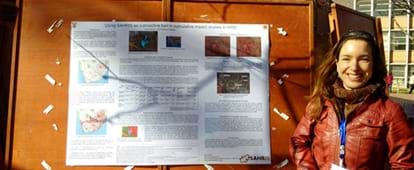
AAbout the author
Katie Smuts holds an MPhil from UCT in Archaeology (History and Archaeology Of the Western Cape; 2012), having specialised in archaeological analysis of historic built fabric and forms. Prior to that, her BA (Hons), obtained from UCT with distinction in 1999, was focused on analysis of depictions of human figures in the rock art of the Western Cape.
Katie has worked both as a commercial archaeologist and as a Heritage Officer for the national Heritage Agency, SAHRA. She was promoted to manager of the National Inventory at SAHRA, where she was responsible for the maintenance of the country’s online heritage management platform and heritage resource database, SAHRIS (the South African Heritage Resources Information System).
Katie serves on the Executive Council of the Association of Southern African Professional Archaeologists (ASAPA), and holds accreditation in rock art, coastal shell middens, Stone Age archaeology and grave relocation. She currently works as a freelance heritage practitioner and archaeological consultant, drafting Heritage Impact Assessments, Archaeological Impact Assessments, Heritage Inventories, heritage scoping reports and heritage components for Strategic Environmental Assessments, Environmental Management Frameworks and similar planning initiatives.
Relayed articles

